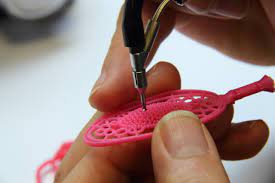Goldsmith: Engraving and Embossing
R: INFORMATION TECHNOLOGY- INFORMATION TECHNOLOGY ENABLED SERVICES (ITITES)ces Helpdesk Attendant
SECTOR: GEMS & JEWELLERY
SUB-SECTOR: Handmade gold and gems-set jewellery
OCCUPATION: Gold smithy (Specialised)
REFERENCE ID: G&J/Q0903
ALIGNED TO: NCO-2004/7313.28
Engraving and Embossing Goldsmith: Also known as ‘Repousse goldsmith’,
the Embossing Goldsmith makes specialised jewellery including Temple
jewellery using embossing or repousse technique.
Brief Job Description: The individual works with hand and machine tools
to make specialised jewellery of gold using engraving (naqqashi) and
embossing or repousse method. The individual is also makes specific tools
for embossing. It is a highly technical and creative job role.
Personal Attributes: The job requires the individual to have: aptitude for
designing; attention to details; good eyesight; steady hands; ability to work
for long hours in sitting position; and a lot of patience. The individual must
also be able to use reflective skills in order to replicate the designs and
work processes, and avoid errors and hazards.
Unit Code G&J /N0903
Unit Title
(Task) Make jewellery components using embossing technique
Description This OS unit is about making specialised jewellery including temple jewellery using a
combination of engraving (naqquashi) and embossing technique and making the
required tools
Scope This unit/task covers the following:
Collect raw materials for making embossed components
Prepare tools
Sketch the design of the jewellery in the gold sheet
Emboss the jewellery from the back side
Engrave the embossed component on the front side
Finish the embossing and engraving work
Check the finished jewellery
Performance Criteria(PC) w.r.t. the Scope
Element Performance Criteria
Making the temple
jewellery
To be competent, the user/individual on the job must be able to:
PC1. receive the jewellery design from the supervisor
PC2. roll gold sheet as per size required using sheet rolling machine
PC3. collect necessary wax and place it on the table where the embossing work will
be done
PC4. understand the design requirement and collect the tools which are required
for embossing
PC5. make the engravers and embossing nails as per the design if they are not
available in specific size and shape
PC6. anneal the engraverl and sharpen them as per the size required for making the
jewellery
PC7. place the gold sheet with the design sketch facing back side of the jewellery on
top of the wax
PC8. emboss or rack the jewellery from the back side in the empty portion of the
sketch by hitting them using specialised tool
PC9. use tools of various sizes to create depth in different parts of the sheet as per
design
PC10. ensure that the sheet is not damaged while embossing
PC11. ensure that appropriate depth is created in required portion of the
component, as per the design
PC12. remove the embossed sheet from the wax and visually check for finishing
PC13. place the embossed component on top of the wax facing the front side
PC14. engrave the embossed component on front side to provide finishing as per
design
PC15. use appropriate engraving nails of different size to provide finish as per design
PC16. ensure that there is no damage to the component while using sharp tools for
engraving
PC17. remove the jewellery from the wax and visually check for finishing
PC18. bring clarity to the face of the motif, usually a god in temple jewellery style
PC19. rework wherever necessary
PC20. remove the unwanted areas in the “net cutting” process in “naqquashi”
PC21. accurately and consistently etch the design in gold sheet
PC22. ensure that the gold sheet is not damaged during etching and it is even
PC23. create appropriate depth from the back side while embossing
PC24. engrave the component accurately as per design on the front side using
different engravers
PC25. accurately capture the face of motif (or the god in temple jewellery) as per
design
PC26. remove the unwanted portions carefully without damaging the embossing
PC27. ensure that all parts of the embossing is finished as per design
PC28. ensure that there is no damage of gold sheet during embossing and engraving
process
Preparation of tools To be competent, the user/individual on the job must be able to:
PC29. understand the design and pick appropriate tools
PC30. make tools by annealing and other methods as per requirement
Checking quality To be competent, the user/individual on the job must be able to:
PC31. visually check the finished jewellery for design and completion of work
PC32. submit the finished component to supervisor or production manager for
further finishing work by filing, soldering, and polishing
PC33. deliver the embossed components on time by reporting problems faced or
anticipated well in advance
A. Organizational
Context
(Knowledge of the
company /
organization and
its processes)
The individual on the job needs to know and understand:
KA1. company’s policies on: acceptable limits of gold loss per product type;
delivery timelines; safety and hazards; integrity; and personnel management
KA2. work flow involved in company’s jewellery manufacturing process and time
required to complete each stage
KA3. importance of the individual’s role in the workflow
KA4. reporting structure
B. Technical
Knowledge
The user/individual on the job needs to know and understand:
KB1. entire process of specialised jewellery making such as Temple jewellery
KB2. embossing and engraving techniques
KB3. different types of embossed/temple jewellery, region wise, and their
specifications
KB4. design of the embossing/temple jewellery from dimensions on paper sketch
KB5. prepare wax and other materials required for embossing
KB6. different type of tools used in embossing/temple jewellery making
KB7. different types of gold alloys and their properties such as malleability and
hardness
KB8. racking and net cutting process required for etching the design
Basic reading and writing skills
The individual on the job needs to know and understand how:
SA1. to read notes and put notes on design
SA2. to read company policy documents
SA3. to read about embossing/temple jewellery making techniques
Calculation and Geometry skills
The individual on the job needs to know and understand how:
SA4. to assess gold loss at each step of jewellery making so as to deliver product of
correct weight and size
SA5. to translate design into finished temple jewellery using embossing technique
Teamwork and multitasking
The individual on the job needs to know and understand how:
SA6. to share work load with other goldsmiths
SA7. to deliver the embossed components in time
The individual on the job needs to know and understand how:
SB1. to select required engravers as per design requirement
SB2. to prepare tools as per design according to various sizes
SB3. to hit the tools or engraving nails with appropriate pressure for the desired
output without damaging the product
SB4. to use fire in the oven or furnace for annealing the tools
SB5. to manually sharpen the engraver on rough stone as per the size required
SB6. to use tools without damaging the embossing or gold sheet
SB7. to understand hazards involved with chemicals, furnaces and tools used
Reducing precious-metal loss
The user/individual on the job needs to know and understand:
SB8. how to reduce precious metal loss below the prescribed standards
SB9. how to collect broken pieces, account in job sheet and return
SB10. how to follow company’s policies on collecting gold dust and fragments
SB11. how to suggest improvements in order to reduce precious metal loss limits
Reflective thinking
The individual on the job needs to know and understand how:
SB12. to improve work processes
SB13. use correct posture for performing the job without injuring body parts
SB14. to reduce gold loss and rework
Critical thinking
The individual on the job needs to know and understand how:
SB15. to spot process disruptions and delays
Unit Title
(Task) Respect IPR of company as well as competitors
Description This OS unit is about maintaining company’s IPR and avoiding infringement on
copyright of others
Scope This unit/task covers the following:
Protect company’s Intellectual Property Rights (IPR)
Avoid infringement to copyright of other companies
Performance Criteria(PC) w.r.t. the Scope
Element Performance Criteria
Respecting IPR To be competent, the user/individual on the job must be able to:
PC1. prevent leak of new designs to competitors by reporting on time
PC2. spot any infringement of company’s product or design patents
PC3. report IPR violations observed in the market, to supervisor or company heads
PC4. read copyright clause of the material published on the internet and any other
printed material
PC5. consult supervisor or senior management when in doubt about using publicly
available information
PC6. report any infringement observed in the company
PC7. spot plagiarism and report
PC8. understand rationale of patents and IPR
PC9. avoid being involved in IPR violations
Knowledge and Understanding (K)
A. Organizational
Context
The individual on the job needs to know and understand:
KA1. company’s policies on IPR, plagiarism and order leaks
KA2. company’s patented products
KA3. market trends and company’s unique product range
KA4. reporting structure
B. Technical
Knowledge
The individual on the job needs to know and understand:
KB1. basics of patents and IPR laws
KB2. how IPR protection is important for competitiveness of a company
Skills (S) [Optional]
A. Core Skills/
Generic Skills
Communication skills
The user/individual on the job needs to know and understand how:
SA1. to effectively communicate any observed IPR violations or design leaks
B. Professional Skills Decision making
The user/individual on the job needs to know and understand when and how:
SB1. to report sources of IPR violations
Reflective thinking
The user/individual on the job needs to know and understand how:
SB2. to learn from past mistakes and report IPR violations on time
Critical thinking
The user/individual on the job needs to know and understand how:
SB3. to spot signs of violations and alert authorities in time
Unit Code G&J/N9912
Unit Title
(Task) Interact with colleagues and seniors
Description This OS unit is about communicating with colleagues and seniors in order to maintain
smooth ad hazards free work flow
Scope This unit/task covers the following:
Interact with supervisor
Interact with colleagues within and outside the department
Performance Criteria(PC) w.r.t. the Scope
Element Performance Criteria
Interaction with
supervisor
To be competent, the user/individual on the job must be able to:
PC1. receive and understand work instructions from reporting superior
PC2. communicate to reporting supervisor about process flow improvements,
product defects received from previous process, repairs and maintenance of
tools and machinery as required
PC3. communicate any potential hazards or expected process disruptions
PC4. handover completed work to supervisor
PC5. understand the work output requirements
PC6. comply with company policy and rule
PC7. deliver quality work on time as required by reporting any anticipated reasons
for delays
Interactions with
colleagues and other
departments
To be competent, the user/individual on the job must be able to:
PC8. work as a team with colleagues and share work as per their or own work load
and skills
PC9. work with colleagues of other departments such as frame making or
component making or polishing or setting or stores
PC10. communicate an discuss work flow related difficulties in order to find solutions
with mutual agreement
PC11. receive feedback from QC and rework in order to complete work on time
PC12. put team over individual goals
PC13. resolve conflicts and multi-task
Knowledge and Understanding (K)
A. Organizational
Context
(Knowledge of the
company /
organization and
its processes)
The individual on the job needs to know and understand:
KA1. company’s policies on personnel management
KA2. work flow involved in company’s jewellery manufacturing process
KA3. importance of the individual’s role in the workflow
KA4. reporting structure
B. Technical
Knowledge
The individual on the job needs to know and understand:
KB1. how to communicate effectively
KB2. how to build team coordination
Skills (S) [Optional]
A. Core Skills/
Generic Skills
Teamwork and some multitasking
The individual on the job needs to know and understand how:
SA1. to share work load as required
SA2. to deliver product to next work process on time
B. Professional Skills Decision making
The individual on the job needs to know and understand:
SB1. how to report potential areas of disruptions to work process
SB2. when to report to supervisor and when to deal with a colleague depending on
the type of concern
Reflective thinking
The individual on the job needs to know and understand:
SB5. how to improve work process
Critical thinking
The individual on the job needs to know and understand:
SB6. how to spot process disruptions and delays
Unit Code G&J/N9914
Unit Title
(Task) Work towards having a safe work environment
Description This OS unit is about being aware of and communicating potential hazards and
dangers of accidents on the job
Scope This unit/task covers the following:
Understand potential sources of accidents
Communicate to reporting supervisor about hazards in time
Performance Criteria(PC) w.r.t. the Scope
Element Performance Criteria
Understanding of
potential sources of
accidents and
communicating
To be competent, the user/individual on the job must be able to:
PC1. avoid accidents related to use of potentially dangerous chemicals, gas torches,
sharp tools and hazards from machines
PC2. suggest process flow improvements to reduce anticipated or repetitive hazards
PC3. report mishandling of tools, machines or hazardous materials
PC4. identify electrical problems that could result in accident
PC5. spot and report potential hazards on time
PC6. follow company policy and rules regarding hazardous materials
PC7. deliver quality work on time as required by reporting any anticipated reasons
for delays
Knowledge and Understanding (K)
A. Organizational
Context
(Knowledge of the
company /
organization and
its processes)
The individual on the job needs to know and understand:
KA1. company’s policies on handling: harmful chemicals and sharp tools, safety and
hazards of machines, fire safety and, disposal of harmful chemicals and
materials
KA2. work flow involved in company’s jewellery manufacturing process
KA3. importance of the individual’s role in the workflow
KA4. reporting structure
B. Technical
Knowledge
The individual on the job needs to know and understand:
KB1. how different chemicals react and what could be the danger from them
KB2. how to use machines and tools without causing bodily harm
KB3. fire safety education
KB4. disposal of hazardous chemicals, tools and materials by following prescribed
environmental norms or as per company policy
Skills (S) [Optional]
A. Core Skills/
Generic Skills
Communication skills
The individual on the job needs to know and understand how:
SA1. to effectively communicate the danger
B. Professional Skills Decision making
The individual on the job needs to know and understand:
SB1. importance of reporting potential sources of danger
SB2. appropriate actions to be taken in the event of an accident
SB3. process for disposing of hazardous materials, safely and following
environmental guidelines
Reflective thinking
The individual on the job needs to know and understand how:
SB4. to learn from past mistakes regarding use of hazardous machines or
chemicals or gas torches
Critical thinking
The individual on the job needs to know and understand:
SB5. how to spot danger
SB6. procedures to follow in the event of a fire or other hazard
Keywords /Terms Description
Sector Sector is a conglomeration of different business operations having similar
business and interests. It may also be defined as a distinct subset of the
economy whose components share similar characteristics and interests.
Sub-sector Sub-sector is derived from a further breakdown based on the
characteristics and interests of its components.
Occupation Occupation is a set of job roles, which perform similar/ related set of
functions in an industry.
Function Function is an activity necessary for achieving the key purpose of the
sector, occupation, or an area of work, which can be carried out by a
person or a group of persons. Functions are identified through functional
analysis and form the basis of OS.
Sub-function Sub-functions are sub-activities essential to fulfil the achieving the
objectives of the function.
Job role Job role defines a unique set of functions that together form a unique
employment opportunity in an organisation.
Occupational Standards
(OS)
OS specify the standards of performance an individual must achieve
when carrying out a function in the workplace, together with the
knowledge and understanding they need to meet that standard
consistently. Occupational Standards are applicable both in the Indian
and global contexts.
Performance Criteria Performance criteria are statements that together specify the standard of
performance required when carrying out a task.
National Occupational
Standards (OS)
NOS are occupational standards which apply uniquely in the Indian
context.
Qualifications Pack (QP) QP comprises the set of OS, together with the educational, training and
other criteria required to perform a job role. A QP is assigned a unique
qualifications pack code.
Unit Code Unit code is a unique identifier for an Occupational Standard, which is
denoted by an ‘N’
Unit Title Unit title gives a clear overall statement about what the incumbent
should be able to do.
Description Description gives a short summary of the unit content. This would be
helpful to anyone searching on a database to verify that this is the
appropriate OS they are looking for.
Scope Scope is a set of statements specifying the range of variables that an
individual may have to deal with in carrying out the function which have
a critical impact on quality of performance required.
Knowledge and
Understanding
Knowledge and understanding are statements which together specify the
technical, generic, professional and organisational specific knowledge
that an individual needs in order to perform to the required standard.
Organisational Context Organisational context includes the way the organisation is structured
and how it operates, including the extent of operative knowledge
managers have of their relevant areas of responsibility.
Technical Knowledge Technical knowledge is the specific knowledge needed to accomplish
Core Skills/ Generic
Skills
Core skills or generic skills are a group of skills that are the key to learning
and working in today’s world. These skills are typically needed in any
work environment in today’s world. These skills are typically needed in
any work environment. In the context of the OS, these include
communication related skills that are applicable to most job roles.
Keywords /Terms Description
IPR Intellectual Property Rights
NOS National Occupational Standard(s)
NVQF National Vocational Qualifications Framework
NSQF National Qualifications Framework
NVEQF National Vocational Education Qualifications Framework
QP Qualifications Pack
CRITERIA FOR ASSESSMENT OF TRAINEES
Job Role Engraving & Embossing
Qualification
Pack Engraving & Embossing
Sector Skill
Council GEMS & JEWELLERY
To pass the Assessment, a candidate needs to score 50% in Theory and 70% in Practical
Assessment Strategy Marks Allocation
NOS Elements Performance Criteria Theory Practical
G&J/N0903
Use embossing
technique to
make jewellery
components
from precious
metals
Making the temple
jewellery
PC1. understand the work requirement by reading the design 0 7
PC2. accurately and consistently etch the design in gold sheet 1 7
PC3. ensure that the gold sheet is not damaged during etching and it is
even
1 7
PC4. create appropriate depth from the back side while embossing 1 7
PC5. engrave the component accurately as per design on the front
side using different engravers 1 6
PC6. accurately capture the face of motif (or the god in temple
jewellery) as per design 0 6
PC7. remove the unwanted portions carefully without damaging the
embossing 2 6
PC8. ensure that all parts of the embossing is finished as per design 1 6
PC9. ensure that there is no damage of gold sheet during embossing
and engraving 1 7
Preparation of tools PC10. understand the design and pick appropriate tools 1 6
PC11. make tools by annealing and other methods as per requirement 2 3
Handling problems PC12. deliver the embossed components on time by reporting
problems faced or anticipated well in advance 1 2
Sub Total 12 70
- G&J/N9901
Maintain IPR
and respect
copyright
Respecting IPR
PC1. Spot plagiarism and report 0 1
PC2. understand rationale of patents and IPR 0 1
PC3. avoid being involved in IPR violations 0 1
Sub Total 0 3 - G&J/N1903
Coordinate with
Others
Interaction with
supervisor
PC1. Understand the work output requirements 1 2
PC2. Comply with Company policy and rule 1 1
PC3. Deliver quality work on time as required by reporting any
anticipated reasons for delays 0 1
Interactions with
colleagues and other
departments
PC4. Put team over individual goals 0 0
PC5. Conflicts resolution and multi-tasking 0 1
Sub Total 2 5
- G&J/N1907
Maintain safe
work
environment
Understanding of
potential sources of
accidents and
communicating
PC1. Spot and report potential hazards on time 2 1
PC2. Follow company policy and rules regarding use of hazardous
materials 1 0
PC3. Deliver quality work on time as required by reporting any
anticipated reasons for delays 3 1
Sub Total 6 2
Total 20 80









